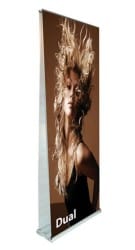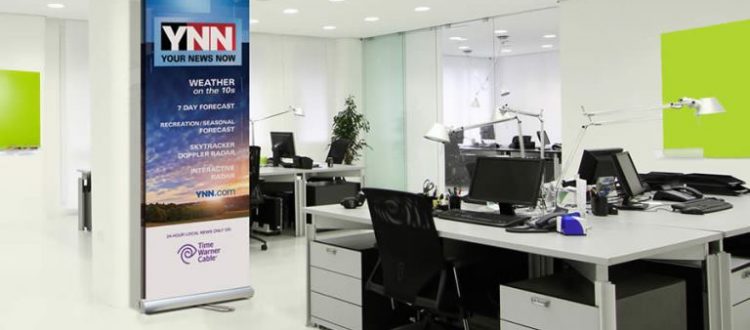Vinyl and fabric banner substrates in making double-sided printed displays. Know which banner substrate or material is best suited for double-sided banner printing.
Question: What is the best banner for a double-sided application?
Well, this is a loaded question, as there are so many variables when it comes to banners and where they’re used. Banners are probably the most widely used form of temporary or display signage used, and there are two main categories that they fall under, then several sub-categories.
 Vinyl banners have been around for several decades and have gone through several revisions as to how they are decorated, but the basic material hasn’t changed much. My first experience with double-sided banners was in the ‘90’s when the first 18oz. vinyl fabric materials were introduced to our plant by a sales rep from one of our suppliers.
Vinyl banners have been around for several decades and have gone through several revisions as to how they are decorated, but the basic material hasn’t changed much. My first experience with double-sided banners was in the ‘90’s when the first 18oz. vinyl fabric materials were introduced to our plant by a sales rep from one of our suppliers.
Shortly thereafter, another company introduced us to a much lighter weight double-sided vinyl banner material that was easier to handle. At any rate, printing in the early 90’s was typically done using a vinyl plotter (which isn’t really printing) or by screen printing.
In the early 21st Century, we started printing banners using the dye sublimation printing method which used ink printed to a transfer paper which was then infused into polyester fabric using heat and pressure. More frequently now printers are printing using direct-to-fabric inks that are as good as the older heat and pressure method.
Making the Double-sided Fabric Banner
To make a double-sided fabric banner, most frequently we print two banners and sew them back-to-back with a blockout fabric layer between them. There are actual double-sided fabrics for dye sub banners that have an internal blockout layer, but we haven’t been impressed with that fabric enough to offer it to our clients, due to the fact that it wrinkles too easily and we don’t like to cause our clients a bunch of extra work trying to remove the wrinkles.
So that gives you your two basic choices for double sided banners. Now, the question as to which is best. Again, you will need to decide, given your usage for the banner, which type is best, as it won’t always be the same.
Decide According to Its Use
If you’re at a trade show (inside a building or convention center), a double sided dye sublimate printed cloth banner may be superior to a similar vinyl banner. Many of our clients have gotten completely away from vinyl banners as they kind of have a propensity, according to them, to look cheap.
And for an indoor usage, wind will not be an issue. So, my vote for a double sided banner, if it’s being used indoors, would definitely be for the fabric option. It just looks better and makes your company look better. Nothing says “cheap” about a company at a tradeshow more than plastic-y looking signs or banners.
However, if it’s an outdoor venue, or hanging between two light poles over a street, or is on the side of a building, particularly at a long viewing distance, then vinyl would more likely be the better solution. It has superior outdoor durability, and people expect to see vinyl banners out-of-doors because they are out-of-doors and it makes sense and won’t make your firm look cheap using an outdoor double sided vinyl banner.
However, there are some venues which still require double-sided dye sublimated outdoor cloth banners such as light pole banners. Since these are typically smaller than, say, vinyl banners than are hung across a street, they won’t have as much wind load.
Printing of Fabric Banners
These fabric light pole banners can be either screen printed or printed using dye sublimation printing. The fabrics for dye sub printing are typically polyester, whereas screen-printed outdoor fabrics can be polyester or the popular acrylic fabrics.
In conclusion, there is not one answer to your question, but you will need to decide, based on the installation environment which is the best choice. Fabric banners tend to be a bit more costly, but in trade show environments, it will, in our opinion, act as a better sales tool for your company. Vinyl is more durable, generally, for outdoor usage, but fabrics are getting more durable for outdoor usage every year.
Popular Posts:




